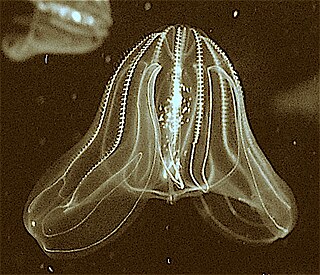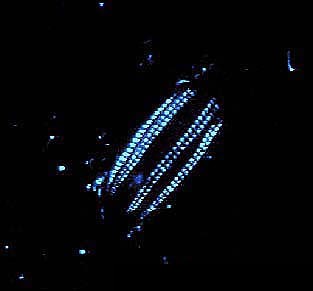Anatomy
The lobates have a pair of lobes, which are muscular, cuplike extensions of the body that project beyond the mouth. Their inconspicuous tentacles originate from the corners of the mouth, running in convoluted grooves and spreading out over the inner surface of the lobes (rather than trailing far behind, as in the Cydippida). Between the lobes on either side of the mouth, many species of lobates have four auricles, gelatinous projections edged with cilia that produce water currents that help direct microscopic prey toward the mouth. This combination of structures enables lobates to feed continuously on suspended planktonic prey. [1]
Lobates have eight comb-rows, originating at the aboral pole and usually not extending beyond the body to the lobes; in species with (four) auricles, the cilia edging the auricles are extensions of cilia in four of the comb rows. Most lobates are quite passive when moving through the water, using the cilia on their comb rows for propulsion, [1] although Leucothea has long and active auricles whose movements also contribute to propulsion. Members of the lobate genera Bathocyroe and Ocyropsis can escape from danger by clapping their lobes, so that the jet of expelled water drives them backwards very quickly. [2]
Unlike cydippids, the movements of lobates' combs are coordinated by nerves rather than by water disturbances created by the cilia, and combs on the same row beat together rather than in Mexican wave style. This may have enabled lobates to grow larger than cydippids and to have shapes that are less egg-like. [3]
An unusual species first described in 2000, Lobatolampea tetragona , has been classified as a lobate, although the lobes are "primitive" and the body is medusa-like when floating and disk-like when resting on the sea-bed. [4]

Cnidaria is a phylum under kingdom Animalia containing over 11,000 species of aquatic animals found both in freshwater and marine environments, including jellyfish, hydroids, sea anemone, corals and some of the smallest marine parasites. Their distinguishing feature is the cnidocytes, specialized cells with ejectable flagella used mainly for envenomation and capturing prey. Their bodies consist of mesoglea, a non-living jelly-like substance, sandwiched between two layers of epithelium that are mostly one cell thick.

Ctenophora comprise a phylum of marine invertebrates, commonly known as comb jellies, that inhabit sea waters worldwide. They are notable for the groups of cilia they use for swimming, and they are the largest animals to swim with the help of cilia.

Beroidae is a family of ctenophores or comb jellies more commonly referred to as the beroids. It is the only family within the monotypic order Beroida and the class Nuda. They are distinguished from other comb jellies by the complete absence of tentacles, in both juvenile and adult stages. Species of the family Beroidae are found in all the world's oceans and seas and are free-swimmers that form part of the plankton.

Bathocyroe fosteri is a species of lobate ctenophore found at intermediate depths in all the world's oceans. The species is very common and abundant near the Mid-Atlantic Ridge. It is bioluminescent, and is typically observed hanging motionlessly in an upright or inverted posture although it can flap its oral lobes to swim. This deep-sea comb jelly is named for Alvin (DSV-2) pilot Dudley Foster, who collected the first specimens.

Mnemiopsis leidyi, the warty comb jelly or sea walnut, is a species of tentaculate ctenophore. It is native to western Atlantic coastal waters, but has become established as an invasive species in European and western Asian regions. Three species have been named in the genus Mnemiopsis, but they are now believed to be different ecological forms of a single species M. leidyi by most zoologists.

Lampocteis is a monotypic genus of comb jellies, the only genus in family Lampoctenidae. The sole species in this new genus is Lampocteis cruentiventer, the bloodybelly comb jelly. This ctenophore was first collected in the Pacific Ocean off the coast of San Diego, California, in 1979. It was described in 2001. The generic name was formed from the Ancient Greek lampós and kteís ("comb"), referring to the iridescence of its "combs"; the specific epithet was formed from the Latin cruentus ("blood-red") and venter ("belly"). Two morphological differences separating it from previously known comb jellies warranted the naming of a new family for this animal. These jellies are typically found at a depth of 250-1,500 meters deep in the North Pacific Ocean.

Ocyropsis is a genus of Ctenophores, which are commonly known as Comb Jellies. Ocyropsis belong to the family of Ocyropsidae. Ocyropsis possesses two large lateral muscular lobes and four auricles, and appear pale and translucent in color. Ocyropsis habitat is not precise as their gelatinous composition can make it difficult to study. They have been found in warm and cold waters. Unlike other, slow swimming Ctenophores, Ocyropsis are efficient in evading their predators. They use their oral lobes for additional propulsion and a secrete luminous mucous in efforts to evade predators. The muscular oral lobes of the Ocyropsis are used to grab its prey, and then moved to the prehensile mouth for absorption.

Cydippida is an order of comb jellies. They are distinguished from other comb jellies by their spherical or oval bodies, and the fact their tentacles are branched, and can be retracted into pouches on either side of the pharynx. The order is not monophyletic, that is, more than one common ancestor is believed to exist.

Pleurobrachia bachei is a member of the phylum Ctenophora and is commonly referred to as the Pacific sea gooseberry. These comb jellies are often mistaken for medusoid Cnidaria, but lack stinging cells.

Mertensia ovum, also known as the Arctic comb jelly or sea nut, is a cydippid comb jelly or ctenophore first described as Beroe ovum by Johan Christian Fabricius in 1780. It is the only species in the genus Mertensia. Unusually among ctenophores, which normally prefer warmer waters, it is found in the Arctic and adjacent polar seas, mostly in surface waters down to 50 metres (160 ft).
The benthic comb jelly is a comb jelly living in the Ryukyu Trench near Japan. Found at a depth of 7,217 metres (23,700 ft), it is the deepest dwelling ctenophore discovered.

Leucothea is a genus of ctenophores in the monotypic family Leucotheidae.

Beroe ovata is a comb jelly in the family Beroidae. It is found in the South Atlantic Ocean and the Mediterranean Sea and has been introduced into the Black Sea, the Aegean Sea, the Sea of Azov and the Caspian Sea. It was first described by the French physician and zoologist Jean Guillaume Bruguière in 1789.

Bolinopsis infundibulum, commonly known as the common northern comb jelly, is a species of comb jelly in the family Bolinopsidae. It is found in the northern Atlantic Ocean and was first described by the Danish naturalist Otto Friedrich Müller in 1776.

Pleurobrachia pileus is a species of comb jelly, commonly known as a sea gooseberry. It is found in open water in the northern Atlantic Ocean, the North Sea, the Baltic Sea and the Black Sea, and was first described by the Danish zoologist Otto Friedrich Müller in 1776.

Thalassocalyce is a genus of ctenophore, or comb jellies, known from the California Coast, Gulf of Mexico, and west north Atlantic. It is represented by a single species, Thalassocalyce inconstans, which is the only species in the family Thalassocalycidae and the order Thalassocalycida. T. inconstans is a pelagic ctenophore typically occurring in upper-mesopelagic depths, but has been observed at depths up to 3,500 m in Monterey Canyon.

Beroe abyssicola is a species of beroid ctenophore, or comb jelly. It is largely found in deep waters in the North Pacific Ocean, and is common in Japan and the Arctic Ocean. A predator, Beroe feeds mostly on other ctenophores by swallowing them whole. Like other ctenophores, B. abyssicola has a simple nervous system in the form of a nerve net, which it uses to direct its movement, feeding, and hunting behaviors.

Euplokamis is a genus of ctenophores, or comb jellies, belonging to the monotypic family Euplokamididae. It shares the common name sea gooseberry with species of the genus Pleurobrachia. Despite living for hundreds of millions of years in marine environments, there is minimal research regarding Euplokamis, because they are uncommon. Research on the evolution of the basic body structures of diploblastic metazoans revealed that there are four major phyla, including the Ctenophores. Although the morphology of Euplokamis often resembles the medusa stage of Cnidarians, their eight rows of combs are one distinguishing feature that led to the official classification of Ctenophores. After being originally described by Chun (1879), the family Euplokamididae was expanded by Mills (1987) due to the discovery of a new species, Euplokamis dunlapae. Further research indicated that Euplokamis should be identified from Mertensiidae due to the rows of combs and some compression. They may also be distinguished from the genus Pleurobrachia due to their more elongated shape. Additionally, various adaptations of Euplokamis have been observed such as the use of tentacles for movement/feeding, a complex nervous system, and bioluminescent capabilities. Other characteristics including a defined mesoderm, lack of stinging cells, developmental differences, and symmetry supported the reclassification of these organisms.
Beroe gracilis is a species of comb jelly in the family Beroidae. It is a free-swimming species found in the North Sea, the Atlantic Ocean and the Mediterranean Sea.
Callianira antarctica is a species of ctenophore that physically resembles Mertensia ovum, but lacks the oil sacs. Just like other ctenophores, over 95% of its body mass and composition is water.

















